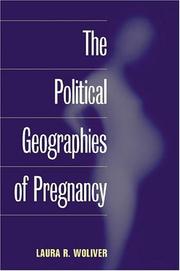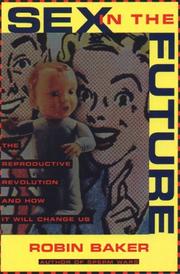| Listing 1 - 10 of 166 | << page >> |
Sort by
|
Book
ISBN: 0128135719 0128135700 9780128135716 9780128135709 Year: 2019 Publisher: London : Academic Press,
Abstract | Keywords | Export | Availability | Bookmark
 Loading...
Loading...Choose an application
- Reference Manager
- EndNote
- RefWorks (Direct export to RefWorks)
Human Reproductive and Prenatal Genetics presents the latest material from a detailed molecular, cellular and translational perspective. Considering its timeliness and potential international impact, this all-inclusive and authoritative work is ideal for researchers, students, and clinicians worldwide. Currently, there are no comprehensive books covering the field of human reproductive and prenatal genetics. As such, this book aims to be among the largest and most useful references available.--
Human reproductive technology. --- Assisted conception --- Assisted human reproduction --- Assisted human reproductive technology --- Conception --- Human assisted reproduction --- Human assisted reproductive technology --- Human reproduction --- Medical technology --- Reproductive technology --- Technological innovations
Book
ISBN: 1624178766 9781624178764 1624178758 9781624178757 Year: 2013 Publisher: Hauppauge, N.Y. : Nova Science Publishers, Inc.,
Abstract | Keywords | Export | Availability | Bookmark
 Loading...
Loading...Choose an application
- Reference Manager
- EndNote
- RefWorks (Direct export to RefWorks)
Human reproductive technology. --- Assisted conception --- Assisted human reproduction --- Assisted human reproductive technology --- Conception --- Human assisted reproduction --- Human assisted reproductive technology --- Human reproduction --- Medical technology --- Reproductive technology --- Technological innovations
Book
ISBN: 9783030477677 Year: 2022 Publisher: Cham Springer International Publishing :Imprint: Springer
Abstract | Keywords | Export | Availability | Bookmark
 Loading...
Loading...Choose an application
- Reference Manager
- EndNote
- RefWorks (Direct export to RefWorks)
Human reproductive technology. --- Assisted conception --- Assisted human reproduction --- Assisted human reproductive technology --- Conception --- Human assisted reproduction --- Human assisted reproductive technology --- Human reproduction --- Medical technology --- Reproductive technology --- Technological innovations
Book
ISBN: 9781498570657 Year: 2019 Publisher: Lanham : Lexington Books,
Abstract | Keywords | Export | Availability | Bookmark
 Loading...
Loading...Choose an application
- Reference Manager
- EndNote
- RefWorks (Direct export to RefWorks)
Human reproductive technology --- Fertility, Human --- Assisted human reproduction --- Assisted conception --- Conception --- Human assisted reproduction --- Human reproduction --- Medical technology --- Reproductive technology --- Human fertility --- Natality --- Demography --- Infertility --- Technological innovations --- Human reproductive technology. --- Fertility, Human. --- Assisted human reproductive technology --- Human assisted reproductive technology

ISBN: 1283155710 9786613155719 0252092945 9780252092947 0252027787 9781283155717 9780252027789 0252075978 9780252075971 0252027787 6613155713 Year: 2002 Publisher: Urbana : University of Illinois Press,
Abstract | Keywords | Export | Availability | Bookmark
 Loading...
Loading...Choose an application
- Reference Manager
- EndNote
- RefWorks (Direct export to RefWorks)
As reproductive power finds its way into the hands of medical professionals, lobbyists, and policymakers, the geographies of pregnancy are shifting, and the boundaries need to be redrawn, argues Laura R. Woliver. Across a politically charged backdrop of reproductive issues, Woliver exposes strategies that claim to uphold the best interests of children, families, and women but in reality complicate women's struggles to have control over their own bodies. Utilizing feminist standpoint theory and promoting a feminist ethic of care, Woliver looks at the ways modern reproductive politics are shaped by long-standing debates on abortion and adoption, surrogacy arrangements, new reproductive technologies, medical surveillance, and the mapping of the human genome.
Human reproductive technology --- Human reproduction --- Pregnancy --- Assisted conception --- Assisted human reproduction --- Assisted human reproductive technology --- Conception --- Human assisted reproduction --- Human assisted reproductive technology --- Medical technology --- Reproductive technology --- Human physiology --- Reproduction --- Reproductive health --- Reproductive rights --- Gestation --- Physiology --- Political aspects. --- Technological innovations
Book
ISBN: 1442666331 9781442666337 9781442646698 1442646691 9781442614574 1442614579 144266634X Year: 2018 Publisher: Toronto : University of Toronto Press,
Abstract | Keywords | Export | Availability | Bookmark
 Loading...
Loading...Choose an application
- Reference Manager
- EndNote
- RefWorks (Direct export to RefWorks)
"In 2004, the Assisted Human Reproduction Act was passed by the Parliament of Canada. Fully in force by 2007, the act was intended to safeguard the health and safety of Canadians. However, a 2010 Supreme Court of Canada decision ruled that key parts of the act were invalid. Regulating Creation is a collection of essays built around the 2010 ruling. Featuring contributions by Canadian and international scholars, it offers a variety of perspectives on the role of law in dealing with the legal, ethical, and policy issues surrounding changing reproductive technologies. In addition to the in-depth analysis of the Canadian case the volume reflects on how other countries, particularly the U.S., U.K. and New Zealand regulate these same issues. Combining a detailed discussion of legal approaches with an in-depth exploration of societal implications, Regulating Creation deftly navigates the obstacles of legal policy amidst the rapid current of reproductive technological innovation."--
Human reproductive technology --- Assisted conception --- Assisted human reproduction --- Assisted human reproductive technology --- Conception --- Human assisted reproduction --- Human assisted reproductive technology --- Human reproduction --- Medical technology --- Reproductive technology --- Law and legislation --- Government policy --- Technological innovations --- Professional ethics. Deontology --- Medical law --- Canada.
Book
ISBN: 9004346074 9004346066 9789004346062 9789004346079 Year: 2018 Publisher: [S.l.] BRILL
Abstract | Keywords | Export | Availability | Bookmark
 Loading...
Loading...Choose an application
- Reference Manager
- EndNote
- RefWorks (Direct export to RefWorks)
The main argument in this BRP is that assisted reproduction in Israel gives expression to and develops the right to procreate. It is a complex right, and therefore at times no consensus has been reached on the form of its actual application (as in the case of surrogacy and egg donation, and, from a different direction, in that of posthumous sperm retrieval). This right, however, despite the debates on its boundaries, is widely accepted, practiced, and even encouraged in the Israeli context, with a constructive collaboration of three main elements: the Israeli civil legal system, religious law (which in the context of the Israeli majority is Jewish law), and Israeli society and culture.
Human reproductive technology --- Assisted conception --- Assisted human reproduction --- Assisted human reproductive technology --- Conception --- Human assisted reproduction --- Human assisted reproductive technology --- Human reproduction --- Medical technology --- Reproductive technology --- Law and legislation --- Technological innovations --- Israël
Book
ISBN: 3030477665 3030477673 Year: 2022 Publisher: Cham, Switzerland : Springer,
Abstract | Keywords | Export | Availability | Bookmark
 Loading...
Loading...Choose an application
- Reference Manager
- EndNote
- RefWorks (Direct export to RefWorks)
Human reproductive technology. --- Assisted conception --- Assisted human reproduction --- Assisted human reproductive technology --- Conception --- Human assisted reproduction --- Human assisted reproductive technology --- Human reproduction --- Medical technology --- Reproductive technology --- Technological innovations --- Esterilitat --- Medicina preventiva --- Reproducció humana assistida

ISBN: 1559705213 Year: 2000 Publisher: New York : Arcade Pub.,
Abstract | Keywords | Export | Availability | Bookmark
 Loading...
Loading...Choose an application
- Reference Manager
- EndNote
- RefWorks (Direct export to RefWorks)
Human reproductive technology --- Sex --- Procréation médicalement assistée --- Sexualité --- Forecasting --- Social aspects --- Prévision --- Aspect social --- Forecasting. --- Social aspects. --- -Sex --- -Human reproductive technology --- -Assisted human reproduction --- Assisted conception --- Conception --- Human assisted reproduction --- Human reproduction --- Medical technology --- Reproductive technology --- Gender (Sex) --- Human beings --- Human sexuality --- Sex (Gender) --- Sexual behavior --- Sexual practices --- Sexuality --- Sexology --- Technological innovations --- -Forecasting. --- Procréation médicalement assistée --- Sexualité --- Prévision --- Assisted human reproduction --- Assisted human reproductive technology --- Human assisted reproductive technology
Book
ISSN: 07501951 ISBN: 2204079731 9782204079730 Year: 2006 Publisher: Paris: Cerf,
Abstract | Keywords | Export | Availability | Bookmark
 Loading...
Loading...Choose an application
- Reference Manager
- EndNote
- RefWorks (Direct export to RefWorks)
Alors que nous les voulions fécondes, il arrive que nos amours restent stériles. Le ciel serein s’obscurcit alors brutalement, gâchant le bonheur d’un couple que rien ne semblait pouvoir contrarier. La médecine peut aujourd’hui soulager cette souffrance de la stérilité grâce à ce que l’on a coutume d’appeler l’assistance médicale à la procréation (AMP) ou la procréation médicalement assistée (PMA). Bien que relativement efficaces, ces nouvelles pratiques procréatives sont la cible de nombreuses critiques, souvent à caractère éthique. On reproche à l’AMP sa violence, une violence qui forcerait les corps, contrarierait la nature et remodèlerait les rapports habituels de filiation. Cette entreprise critique qui, sous certains aspects, ne manque pas de pertinence, s’exprime cependant de façon tellement outrancière qu’elle en devient proprement injuste. On peut en effet parler d’injustice devant un mouvement critique qui semble ignorer la souffrance des couples infertiles et l’efficacité de la médecine pour alléger cette souffrance. Mais s’il faut reconnaître l’injustice dont elle est victime, il n’est pas pour autant légitime d’offrir un blanc-seing à l’AMP. Très dépendante du développement techno-scientifique, la médecine procréative est entraînée dans une fuite en avant que rien ne semble devoir arrêter, si ce n’est peut-être, justement, la souffrance des patients à laquelle elle est censée répondre et qu’elle pourrait, en débordant, encore amplifier. Pour éviter de tels débordements, l’auteur propose aux praticiens de l’AMP et à leurs patients actuels ou potentiels quelques éléments pour construire une nouvelle éthique amoureuse.
Professional ethics. Deontology --- Reproductive Techniques, Assisted --- Fertilization in Vitro --- Reproductive Techniques --- Ethics, Medical --- Human reproductive technology --- ethics --- Moral and ethical aspects --- 173.4 --- 241.64*8 --- -Assisted human reproduction --- Assisted conception --- Conception --- Human assisted reproduction --- Human reproduction --- Medical technology --- Reproductive technology --- Abortus provocatus. Contraceptie. Kunstmatige inseminatie. Proefbuisbaby's --- Theologische ethiek: kunstmatige inseminatie; leenmoederschap --- Technological innovations --- -Abortus provocatus. Contraceptie. Kunstmatige inseminatie. Proefbuisbaby's --- 241.64*8 Theologische ethiek: kunstmatige inseminatie; leenmoederschap --- 173.4 Abortus provocatus. Contraceptie. Kunstmatige inseminatie. Proefbuisbaby's --- -241.64*8 Theologische ethiek: kunstmatige inseminatie; leenmoederschap --- Assisted human reproduction --- Reproductive Techniques - ethics --- Human reproductive technology - Moral and ethical aspects
| Listing 1 - 10 of 166 | << page >> |
Sort by
|

 Search
Search Feedback
Feedback About UniCat
About UniCat  Help
Help News
News